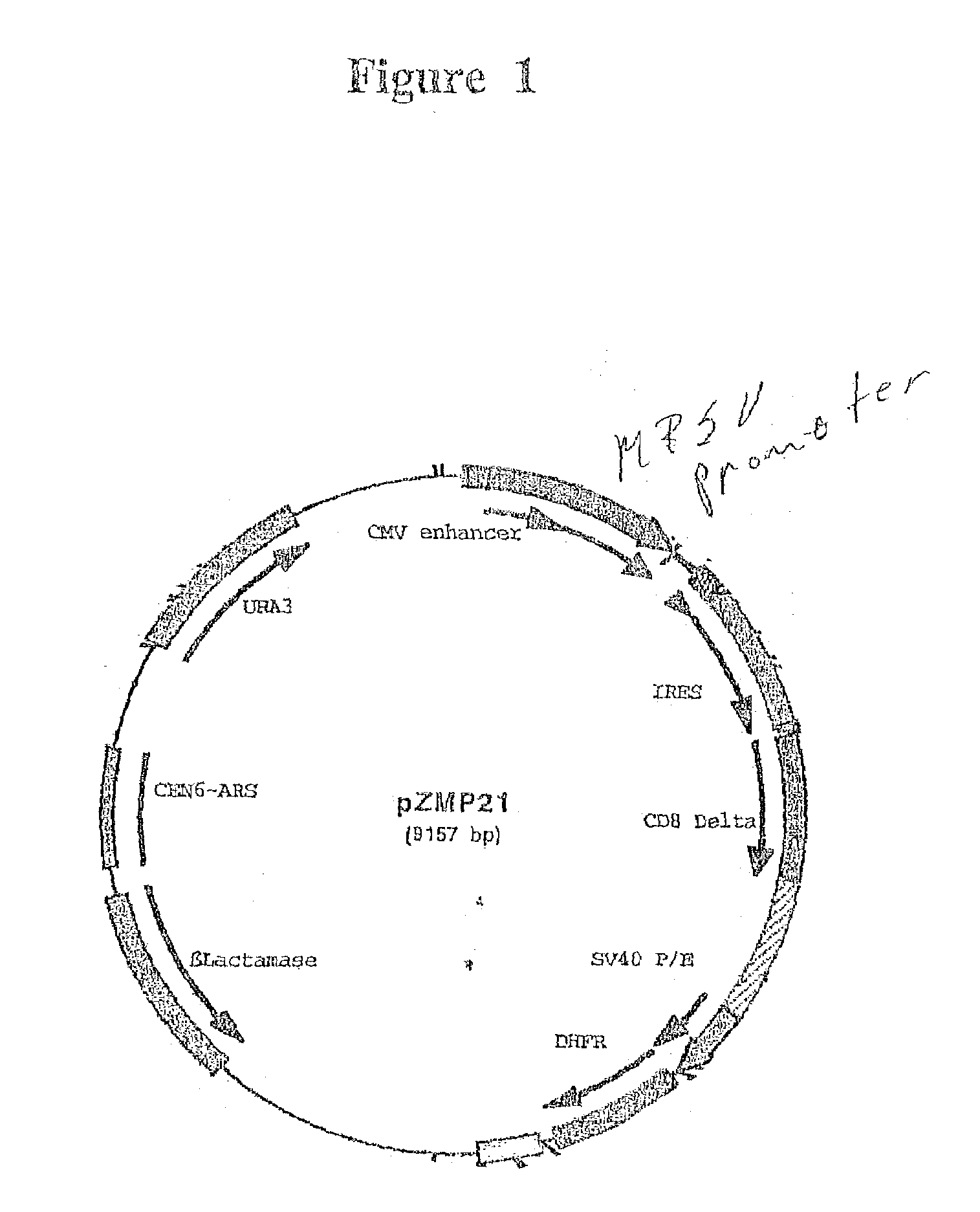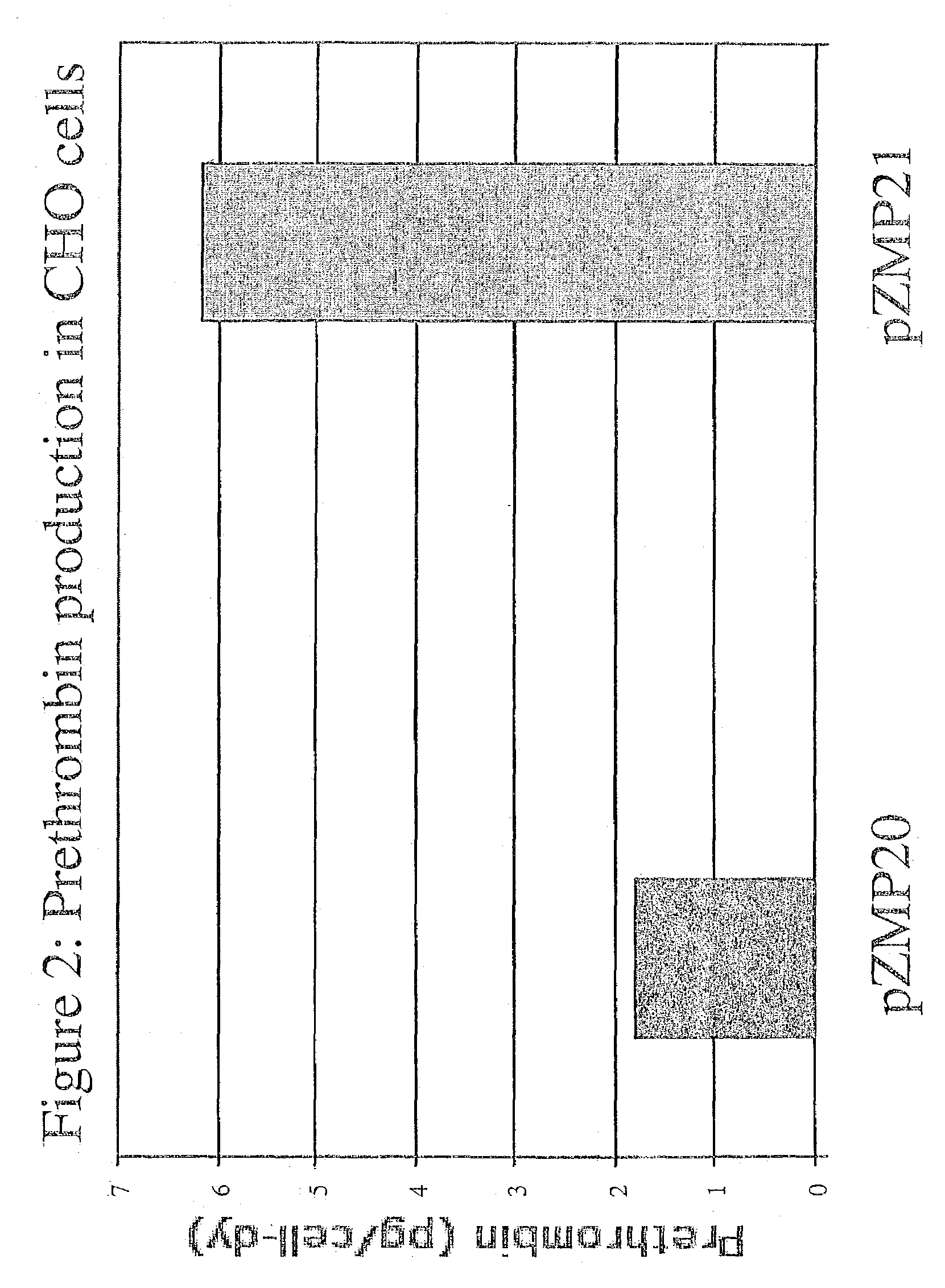Hybrid vector having a cytomegalovirus enhancer and myeloproliferative sarcoma virus promoter
a technology of cytomegalovirus and promoter, which is applied in the field of hybrid vectors having cytomegalovirus enhancers and myeloproliferative sarcoma virus promoters, can solve the problems of reducing the level of protein production, significant drawbacks of retroviral vectors for use in industrial level protein production, and affecting the production of protein
- Summary
- Abstract
- Description
- Claims
- Application Information
AI Technical Summary
Benefits of technology
Problems solved by technology
Method used
Image
Examples
example 1
Construction of MPSV Promoter and pZMP21
[0086]The MPSV LTR promoter was constructed synthetically by assembling oligonucleotides in sets of four using PCR.
[0087]First the oligos were assembled in pairs by PCR:SEQ ID NOs: 4+5, 6+7, 8+9, 10+11, 12+13, 14+15. Then the pairs were assembled into three sets of four oligos SEQ ID NOS: 4+5 and 6+7, with oligos SEQ ID NOs: 4 and 7 as primers, 8+9 and 10+11 with oligos 8 and 11 as primers, and 12+13 and 14+15 with oligos 12 and 15 as primers in PCR reactions. When the three PCR fragments were assembled a smaller than expected product was observed. A new primer, 16, was made to get around the internal repeat that lead to this deletion. The product of 4+7 was, extended with primers 4 and 16 to make a better overlap with the product of 8+15. 4+16 and 8+15 were assembled with primers 4 and 15 by PCR to make a full length product.
[0088]The PCR reactions were run as follows: to a 100 μl final volume was added, 10 μl 10×Taq polymerase Reaction Buffe...
example 2
Construction of Prethrombin Expression Vectors
[0093]An expression plasmid containing all or part of a polynucleotide encoding prethrombin is constructed via homologous recombination. A fragment of prethrombin cDNA is isolated using PCR that includes the polynucleotide sequence from nucleotide 1 to nucleotide 1380 of SEQ ID NO: 15 with flanking regions at the 5′ and 3′ ends corresponding to the vectors sequences flanking the prethrombin insertion point. The primers for PCR each include from 5′ to 3′ end: 40 bp of flanking sequence from the vector and 17 bp corresponding to the amino and carboxyl termini from the open reading frame of prethrombin.
[0094]Ten μl of the 100 μl PCR reaction is run on a 0.8% LMP agarose gel (Seaplaque GTG) with 1×TBE buffer for analysis. The remaining 90 μl of PCR reaction is precipitated with the addition of 5 μl 1 M NaCl and 250 μl of absolute ethanol. The plasmids pZMP20 and pZMP21, described in the previous example, which were cut with BglII were used f...
example 3
Expression of Prethrombin in Protein-free, Suspension-adapted CHO Cells
[0098]Serum-free, suspension-adapted CHO DG44 cells were electroporated with two of the plasmids described above: pZMP21-prethrombin and the control plasmid, pZMP20-prethrombin, by the following method. The plasmids were linearized by digestion with PvuI, precipitated with sodium acetate and ethanol then rinsed with 70% ethanol and dried. The pellets were resuspended at a concentration of 200 μg / 100 μl per electroporation in PFCHO medium supplemented with 4 mM L-Glut, 1% Hypoxanthine / Thymidine, 1% vitamins, and 1% Na pyruvate (Invitrogen). Cells, growing at log phase, were pelleted and resuspended at 5E6 / 800 μl per electroporation reaction. The electroporation was performed in a BioRad GenePulser II with Capacitance extender (BioRad, Hercules, Calif.), at 300 v and 950 μFd in 4 mm cuvettes. The cells were suspended in 25 ml of the medium described above in 125 mL shake flasks and put on shakers in cell culture in...
PUM
| Property | Measurement | Unit |
|---|---|---|
| volume | aaaaa | aaaaa |
| volume | aaaaa | aaaaa |
| volume | aaaaa | aaaaa |
Abstract
Description
Claims
Application Information
 Login to View More
Login to View More - R&D
- Intellectual Property
- Life Sciences
- Materials
- Tech Scout
- Unparalleled Data Quality
- Higher Quality Content
- 60% Fewer Hallucinations
Browse by: Latest US Patents, China's latest patents, Technical Efficacy Thesaurus, Application Domain, Technology Topic, Popular Technical Reports.
© 2025 PatSnap. All rights reserved.Legal|Privacy policy|Modern Slavery Act Transparency Statement|Sitemap|About US| Contact US: help@patsnap.com


